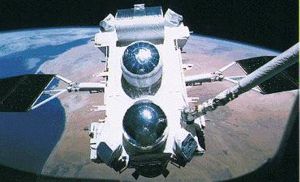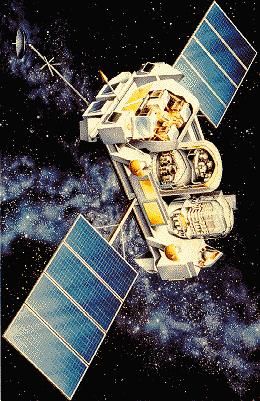
Home - Search - Browse - Alphabetic Index: 0- 1- 2- 3- 4- 5- 6- 7- 8- 9
A- B- C- D- E- F- G- H- I- J- K- L- M- N- O- P- Q- R- S- T- U- V- W- X- Y- Z
GRO
 GRO Deployment Credit: NASA |
AKA: Compton;Compton Gamma Ray Observatory;Gamma Ray Observatory. Status: Operational 1991. First Launch: 1991-04-05. Last Launch: 1991-04-05. Number: 1 . Gross mass: 15,620 kg (34,430 lb). Height: 9.10 m (29.80 ft). Span: 21.30 m (69.80 ft).
The spacecraft carried seven tons of instruments to detect, image and analyze gamma rays emitted by cataclysmic cosmic events. CGRO was to have addressed fundamental questions about the process of energy transfer in the universe and lead to a better understanding of the nature of astronomical objects that produce this very high-energy radiation.
The specific objectives of the Compton Gamma Ray Observatory included (1) studying gamma-ray sources emitting in the Milky Way Galaxy and beyond, (2) investigating evolutionary forces in neutron stars and black holes, (3) performing detailed studies of nucleosynthesis, and (4) searching for primordial black hole emissions. The program included participation from Germany, the Netherlands, the United Kingdom, and ESA. The other Great Observatories were the HST (visible), AXAF (X-ray), and SIRTF (infrared).
The spacecraft was 3-Axis stabilized by a zero momentum biased control system using reaction wheels. Two solar array generated 4500 W (BOL) power and fed three 50 Ahr NiCd batteries. The hydrazine propulsion system (with 1900 kg fuel) had four 100-lbf thrusters and eight 5-lbf ACS thrusters. The S-band telecom system used a 1.52 m diameter high gain antenna on a 4.4 m boom. This provided uplink at 1 kbps and downlink (via the TDRSS relay satellite) at 256-512 kbps. GRO was the first spacecraft designed for on-orbit refueling, servicing and maintenance.
Four instruments were carried. The OSSE (Oriented Scintillation Spectrometer Experiment) by the Naval Research Laboratory detected gamma rays entering the field of view of any of four detectors in the 100 kev to 10 Mev range. The Imaging Compton Telescope by the Max Planck Institute was tuned to the 1-30 Mev energy range and determined the angle of arrival within a degree and the energy of photons to within five percent at higher energies. The Energetic Gamma Ray Experiment Telescope (EGRET) measured high energy (20 Mev to 30 gev) gamma ray source positions to a fraction of a degree and photon energy to within 15 percent. EGRET was developed by NASA GSFC, the Max Planck Institute, and Stanford University. The Burst and Transient Source Experiment (BATSE) by NASA MSFC scoured the sky for short duration gamma ray bursts (20 to 600 kev) and conducted full sky surveys for long lived sources.
More at: GRO.
Family: Astronomy, Gamma ray astronomy satellite. Country: USA. Launch Vehicles: Space Shuttle. Launch Sites: Cape Canaveral, Cape Canaveral LC39B. Agency: NASA, TRW. Bibliography: 2, 279, 3745, 6, 11139.
 | GRO Credit: NASA |
 | CGRO Credit: Manufacturer Image |
1991 April 5 - . 14:22 GMT - . Launch Site: Cape Canaveral. Launch Complex: Cape Canaveral LC39B. Launch Platform: MLP1. LV Family: Shuttle. Launch Vehicle: Space Shuttle.
- Compton Observatory - .
Payload: Gamma Ray Observatory. Mass: 15,620 kg (34,430 lb). Nation: USA.
Agency: NASA Greenbelt.
Class: Astronomy.
Type: X-ray astronomy satellite. Spacecraft: GRO.
Decay Date: 2000-06-04 . USAF Sat Cat: 21225 . COSPAR: 1991-027B. Apogee: 453 km (281 mi). Perigee: 448 km (278 mi). Inclination: 28.50 deg. Period: 93.60 min.
Astrophysical laboratory for gamma ray observations; deployed from STS-37 4/7/91; renamed Compton Gamma Ray Observatory. The Compton Gamma Ray Observatory was intentionally deorbited on by NASA over the objections of the scientific community on June 3, 2000. NASA decided to end the mission after several orientation gyroscope failures. They felt that if another gyroscope was lost, the heavy spacecraft might eventually reenter out of control.
Back to top of page
Home - Search - Browse - Alphabetic Index: 0- 1- 2- 3- 4- 5- 6- 7- 8- 9
A- B- C- D- E- F- G- H- I- J- K- L- M- N- O- P- Q- R- S- T- U- V- W- X- Y- Z
© 1997-2019 Mark Wade - Contact
© / Conditions for Use